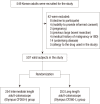A randomized controlled trial of comparison on time and rate of cecal and termianl Ileal intubation according to adult-colonoscope length: intermediate versus long
- PMID: 24431912
- PMCID: PMC3890483
- DOI: 10.3346/jkms.2014.29.1.98
A randomized controlled trial of comparison on time and rate of cecal and termianl Ileal intubation according to adult-colonoscope length: intermediate versus long
Abstract
For a complete colonoscopic examination, a high intubation rate and a short intubation time have been demanded to colonoscopists, if possible. The aim of the present study was to compare these examination parameters, intubation time and rate, according to the length of colonoscope. A total of 507 healthy Korean subjects were randomly assigned into two groups: intermediate length adult-colonoscope (n=254) and long length adult-colonoscope (n=253). There were significant differences in cecal intubation time and in terminal ileal intubation rate according to the length of the colonoscope. Time-to-cecal intubation was shorter for the intermediate-scope group than for the long-scope group (234.2 ± 115.0 sec vs 280.7 ± 135.0 sec, P < 0.001). However, the success rate of terminal ileal intubation was higher in the long-scope group than in the intermediate-scope group (95.3% vs 84.3%, P < 0.001). There were no significant differences in other colonoscopic parameters between the two groups. The intermediate length adult-colonoscope decreased the time to reach the cecum, whereas the long-scope showed a success rate of terminal ileal intubation. These findings suggest that it is reasonable to prepare and use these two types of colonoscope appropriate to the needs of the patient and examination, instead of employing only one type of colonoscope.
Keywords: Colonoscope Length; Colonoscopy; Intubation Rate; Intubation Time.
Conflict of interest statement
The authors have no conflicts of interest to disclose.
Figures





Similar articles
-
Comparison on colonoscopic parameters according to length of adult-colonoscope.Chin Med J (Engl). 2014;127(1):85-91. Chin Med J (Engl). 2014. PMID: 24384429 Clinical Trial.
-
Long pediatric colonoscope versus intermediate length adult colonoscope for colonoscopy.J Gastroenterol Hepatol. 2008 Jul;23(7 Pt 2):e7-e10. doi: 10.1111/j.1440-1746.2007.04864.x. J Gastroenterol Hepatol. 2008. PMID: 18702687 Clinical Trial.
-
Intermediate-length colonoscope needs more training duration than long-length colonoscope.Scand J Gastroenterol. 2014 Aug;49(8):1007-13. doi: 10.3109/00365521.2013.856465. Epub 2014 Jun 24. Scand J Gastroenterol. 2014. PMID: 24957569 Clinical Trial.
-
Meta-analysis of the performance of ultrathin vs. standard colonoscopes.Endoscopy. 2017 Apr;49(4):351-358. doi: 10.1055/s-0042-117110. Epub 2016 Nov 16. Endoscopy. 2017. PMID: 27852099 Review.
-
The efficacy of cap-assisted colonoscopy in polyp detection and cecal intubation: a meta-analysis of randomized controlled trials.Am J Gastroenterol. 2012 Aug;107(8):1165-73. doi: 10.1038/ajg.2012.135. Epub 2012 Jun 5. Am J Gastroenterol. 2012. PMID: 22664471 Review.
Cited by
-
Impact of pediatric versus adult colonoscope on terminal ileum intubation: a retrospective study.Ann Gastroenterol. 2022 Mar-Apr;35(2):169-176. doi: 10.20524/aog.2022.0700. Epub 2022 Feb 21. Ann Gastroenterol. 2022. PMID: 35479588 Free PMC article.
-
Association Between Exposure to Environmental Tobacco Smoke at the Workplace and Risk for Developing a Colorectal Adenoma: A Cross-Sectional Study.Ann Coloproctol. 2016 Apr;32(2):51-7. doi: 10.3393/ac.2016.32.2.51. Epub 2016 Apr 30. Ann Coloproctol. 2016. PMID: 27218095 Free PMC article.
-
Prospective comparison of an adult, an intermediate pediatric and a long pediatric colonoscope in the training process of gastrointestinal fellows to achieve high-quality practice in colonoscopy.Ann Gastroenterol. 2022 Jul-Aug;35(4):400-406. doi: 10.20524/aog.2022.0717. Epub 2022 May 12. Ann Gastroenterol. 2022. PMID: 35784628 Free PMC article.
-
Impact of bowel preparation on caecal intubation time during colonoscopy.Pak J Med Sci. 2019 Nov-Dec;35(6):1516-1519. doi: 10.12669/pjms.35.6.1031. Pak J Med Sci. 2019. PMID: 31777485 Free PMC article.
-
Disease patterns among Saudi children undergoing colonoscopy for lower gastrointestinal bleeding: Single tertiary care center experience.Saudi J Gastroenterol. 2023 Nov-Dec;29(6):388-395. doi: 10.4103/sjg.sjg_130_23. Saudi J Gastroenterol. 2023. PMID: 37706419 Free PMC article.
References
-
- Siegel R, Naishadham D, Jemal A. Cancer statistics, 2013. CA Cancer J Clin. 2013;63:11–30. - PubMed
-
- Sung JJ, Lau JY, Goh KL, Leung WK Asia Pacific Working Group on Colorectal Cancer. Increasing incidence of colorectal cancer in Asia: implications for screening. Lancet Oncol. 2005;6:871–876. - PubMed
-
- Bertelson NL, Kalkbrenner KA, Merchea A, Dozois EJ, Landmann RG, De Petris G, Young-Fadok TM, Etzioni DA. Colectomy for endoscopically unresectable polyps: how often is it cancer? Dis Colon Rectum. 2012;55:1111–1116. - PubMed
Publication types
MeSH terms
LinkOut - more resources
Full Text Sources
Other Literature Sources
Medical

